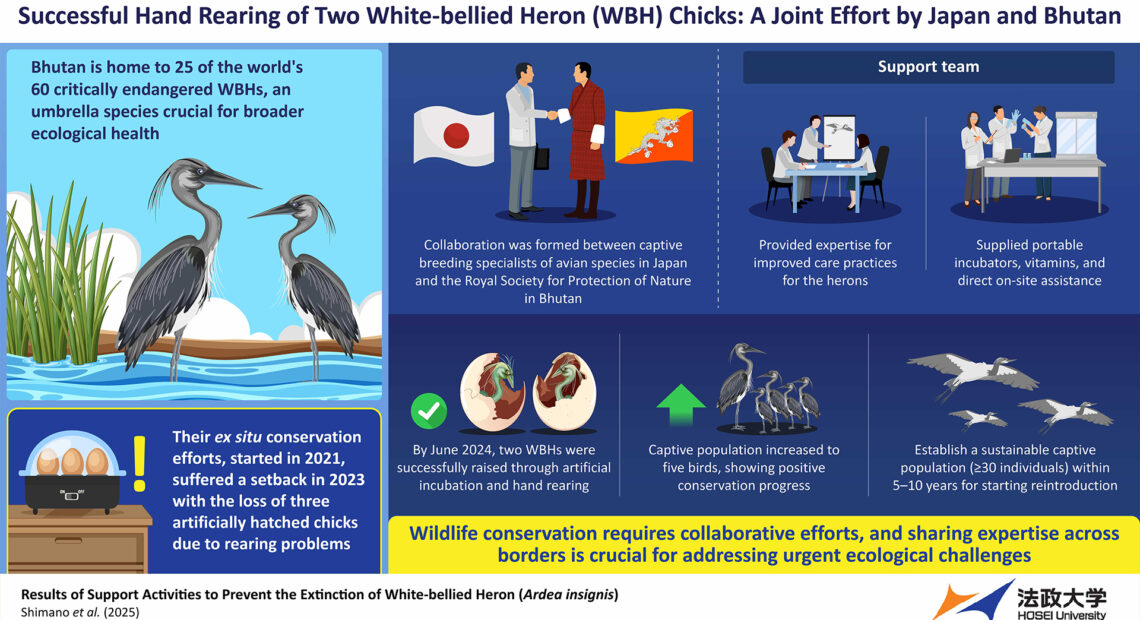Japanese collaboration to save near-extinct herons in Bhutan takes wings

White-bellied Heron is ‘umbrella species’
Passionate captive breeding specialists from Japan and dedicated Bhutan conservationists have successfully hand-reared two chicks of the critically endangered White-bellied Heron (WBH), a species on the brink of extinction.
This breakthrough achievement offers new hope for the survival of the world’s second-largest heron, which faces severe threats from habitat disturbance caused by human activities and predation.
The White-bellied Heron, symbolic to the people of Bhutan, is considered an ‘umbrella species’—meaning its survival is intrinsically linked to preserving vast and undisturbed habitats.
Unfortunately, human development has increasingly encroached upon this heron’s habitat, leading to a dramatic decline in population. As of 2024, fewer than 45 WBHs are estimated to remain in the wild, although the official count is 60. Endemic to the Indian subcontinent, Bhutan is home to approximately 25 herons, making the country crucial in saving the species.
In response to this alarming situation, the Royal Society for Protection of Nature (RSPN) in Bhutan launched an initiative in 2021 to artificially breed WBHs outside their natural habitat.
This initiative led to the establishment of the White-bellied Heron Conservation Centre (WBHCC) in 2022, situated in the mountainous regions of south-central Bhutan. Supported by the Bhutanese government, international donors, and conservation agencies, the centre has been a beacon of hope in the battle against the species’ decline.
The WBHCC houses three captive birds, two of which were rescued as chicks from wild nests and the third a wounded bird. With only a small number of confirmed WBH pairs in Bhutan—between three and four—it is a daunting task to collect eggs and chicks, as these herons build their nests on cliffs and tall trees.
To further complicate matters, macaque monkeys have been known to eat WBH eggs during incubation, making egg collection a perilous undertaking. Despite these challenges, the WBHCC had a significant breakthrough in 2023 by successfully collecting and hatching three eggs.
However, the chicks had to be euthanised due to genetic abnormalities caused by inbreeding, resulting from the species’ dwindling population.
To refine hand-rearing techniques, Bhutan sought support from international experts, most notably Professor Satoshi Shimano of Hosei University in Japan. Professor Shimano, who had witnessed the extinction of Japan’s native strains of the Oriental Stork and the Japanese Crested Ibis, was determined to help prevent Bhutan from making the same mistakes.
He first encountered Pema Khandu, a Bhutanese graduate student focused on conserving the WBH, in 2018. This meeting sparked a collaborative partnership between Japan and Bhutan that would prove pivotal in saving the heron.
In 2023, Japanese veterinarians Dr Takashi Nagamine and Dr Yumiko Nakaya, along with other experts from the Okinawa Wildlife Federation and the Japanese Association of Zoos and Aquariums (JAZA), travelled to Bhutan to assess the WBHCC’s breeding efforts.
They concluded that the chicks’ deaths were more likely due to improper hand-rearing methods than to genetic defects. Armed with their expertise, the Japanese team provided critical guidance to the Bhutanese conservationists, offering daily online support during the 2024 breeding season and donating essential equipment.
The breakthrough came when Japanese experts observed that leg abnormalities, previously an issue for species like the Crested Ibis and Oriental Stork, were also evident in the WBH chicks.
Rei Matsumoto, a senior researcher at the Hyogo Park of the Oriental White Stork, recommended switching the bedding material to twigs that the chicks could better grasp. This adjustment resulted in one of the chicks showing significant improvement in its leg development and growing healthily.
Professor Shimano, committed to conservation efforts for over two decades, emphasised the importance of sharing Japan’s knowledge to prevent further extinctions. He expressed hope that the captive WBH population would grow to around 30 individuals within five to ten years, enabling the release of some birds into the wild.
The RSPN aims to establish 16 founder populations by 2028 and release at least 50 herons into the wild by 2050. These efforts are vital not only for the survival of the White-bellied Heron but also for the broader ecological health of the region.
The successful hand-rearing of these two chicks is a promising step forward. With continued collaboration and support, Bhutan and Japan hope the White-bellied Heron will retake flight in captivity and the wild.
Image: Credit: Hosei University












